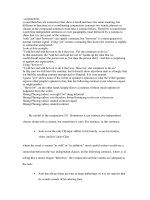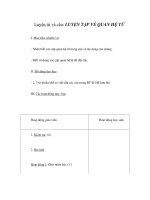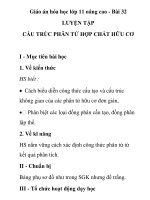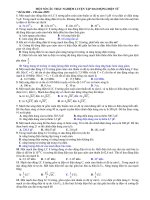Luyen tap cau co lien tu
Bạn đang xem bản rút gọn của tài liệu. Xem và tải ngay bản đầy đủ của tài liệu tại đây (31.54 KB, 2 trang )
: conjunctions
so and therefore are connectors that show a result and have the same meaning, but
different in function; so is coordinating conjunction (connect two words, phrases or
clauses at the compound sentences must take a comma before. Therefore is transitional
word (link independent sentences or even paragraphs, must followed by a comma to
show that it is not a part of the sentence.
both "yet" and "however" can signify contrasts, but "however" is a more general or
neutral contrast-signal. Using "yet" creates a meaning that shows the contrast is slightly
or somewhat unexpected.
Look at this example:
"I told her and told her not to do it that way. Yet she continues to do so."
In that statement, the "told her and told her not to" builds up the idea that we
could/should expect the person not to, but then the person did it - and this is surprising
or against our expectation.
Using "however":
"I told her and told her not to do it that way. However, she continues to do so."
In this case we still have the contrast, but it doesn't show anywhere near as strongly that
we find the resulting contrast unexpected or illogical. It is very neutral.
I guess "yet" shows more of the writer or speaker's opinion (or what the writer/speaker
expects other people's opinion to be), that the following contrast is not what we expect
or might predict.
"However", on the other hand, simply shows a contrast, without much opinion or
judgment from the writer.
Hoang Phuong-yahoo: con nghi "so" dung informal
Hoang Phuong-yahoo: con therefore formal hontuong tu cho yet va however
Hoang Phuong-yahoo: neutral contrast-signal
Hoang Phuong-yahoo: neutral contrast
Be careful of the conjunction SO. Sometimes it can connect two independent
clauses along with a comma, but sometimes it can't. For instance, in this sentence,
• Soto is not the only Olympic athlete in his family, so are his brother,
sister, and his Uncle Chet.
where the word so means "as well" or "in addition," most careful writers would use a
semicolon between the two independent clauses. In the following sentence, where so is
acting like a minor-league "therefore," the conjunction and the comma are adequate to
the task:
• Soto has always been nervous in large gatherings, so it is no surprise that
he avoids crowds of his adoring fans.
Sometimes, at the beginning of a sentence, so will act as a kind of summing up device
or transition, and when it does, it is often set off from the rest of the sentence with a
comma:
So, the sheriff peremptorily removed the child from the custody of his parents.
The word YET functions sometimes as an adverb and has several meanings: in
addition ("yet another cause of trouble" or "a simple yet noble woman"), even ("yet
more expensive"), still ("he is yet a novice"), eventually ("they may yet win"), and so
soon as now ("he's not here yet"). It also functions as a coordinating conjunction
meaning something like "nevertheless" or "but." The word yet seems to carry an
element of distinctiveness that but can seldom register.
• John plays basketball well, yet his favorite sport is badminton.
• The visitors complained loudly about the heat, yet they continued to play
golf every day.
In sentences such as the second one, above, the pronoun subject of the second clause
("they," in this case) is often left out. When that happens, the comma preceding the
conjunction might also disappear: "The visitors complained loudly yet continued to
play golf every day."
Yet is sometimes combined with other conjunctions, but or and. It would not be unusual
to see and yet in sentences like the ones above. This usage is acceptable.









